Balsall Common
Balsall Common Methodist Church, 228 Station Road, Balsall Common, Coventry CV7 7EE covnunmethodist.org.uk
Church opening times
Fridays and Saturdays 11am-4pm
Sundays 1pm-4pm
Events at Balsall Common Methodist ChurchSaturday 4th September
11am-4pm
An interactive art event with a spiritual bias, called Sea of Troubles, based on the Maggi Hambling.
Saturday 11th September
10am-4pm
A full day hands-on creative textile session responding to the art works primarily aimed at the Solihull Creative Textiles group, but open to the public by advance booking, with a small charge made to cover the cost of materials.
Sunday 12th September
1-4pm
A dementia friendly activity.
Saturday 25th September
11.15am-12n and 2.15-3pm
Two family-oriented poetry workshops entitled Take One Word.
Sunday 26th September
2-3.30pm
In the Picture: a workshop on ekphrastic poetry.
Saturday 2nd October
11am-4pm
An art workshop entitled Answering Back.
Stories of Change: Hope, Faith and Love
Introduction
The Methodist Modern Art Collection is one of the Methodist Church’s greatest treasures. This outstanding collection of Christian art has particular strengths in British 20th-century Modern artists including works by Edward Burra, Elisabeth Frink, Patrick Heron, Ceri Richards, Graham Sutherland and William Roberts. The Collection has continued to grow, since its foundation in the 1960s, with innovative acquisitions from the 1990s onwards.
Just as John Wesley, who inspired the Methodist Movement, travelled around the country preaching, so the Methodist Modern Art Collection is not rooted in one place. From the beginning it was conceived as a travelling collection with strong educational links, and has been touring for many years to chapels, churches, cathedrals, museums, galleries and educational establishments, where it has inspired worship, enthused Mission, amazed visitors, and encouraged many supporters and enthusiasts. This unique Collection has recently undergone a programme of conservation and re-framing, to ensure it is preserved for future generations. This is the first time it has been seen by the public in over two years.
Re-launching the Collection during the City of Culture year in Coventry, and opening the Art Trail Stories of Change: Hope, Faith and Love with works on display in the Cathedral itself, set among outstanding masterpieces of 20th-century religious art, is particularly appropriate, as the Collection was begun in 1962, the year that the Cathedral was consecrated. Four works are hung at the Cathedral, all creating new dynamic dialogues between these paintings and the outstanding interior of the Cathedral with its related artworks. This is followed by a trail across the city, and beyond, enabling the exploration of the Collection in depth within the context of the communities who are hosting the trail, along with their responses to the works, at a time of recovery from the Covid-19 pandemic.
An innovative Art Trail for Coventry – Stories of Change: Hope, Faith and Love
The Church of England’s post-war response to church artistic commissioning is well known; epitomised by the brilliant architecture and art commissioned by the architect Sir Basil Spence at Coventry Cathedral. The Methodist Church’s engagement with post-war British religious art is less well known and, historically, art commissioning has not been at the forefront of non-conformist church activities. The unique story of the formation of the Methodist Modern Art Collection, from its foundation in 1962, is told in this trail, demonstrating how it has grown to include more artists from other parts of the world, to reflect multicultural Britain. Today it also plays a role in post-Covid recovery, offering moments of contemplation and healing.
For nearly 60 years these works have surprised, delighted and enthused many hundreds of thousands of people who have seen and appreciated them in churches, cathedrals and art galleries across the UK. We hope, here in Coventry, visitors will take the opportunity to engage with these works anew and follow the trail from the Cathedral, to Methodist Central Hall and onwards to Earlsdon Methodist Church, Balsall Common Methodist Church and Saint Mary and All Saints Church at Fillongley (a longstanding and successful example of a Local Ecumenical Partnership between the local Anglican and the Methodist churches). In all of these venues we hope they discover more about these significant paintings and their message of hope, faith and love.
This Art Trail provides information about the works that can be found at each location and how the local community responded to these, as well as explaining how to navigate the trail from the city centre out into the delightful villages nearby. A printed leaflet will be available at each of the venues.
The artists represented in the Collection may have been war artists like Graham Sutherland, or refugees like Ralph Beyer, or brought up during World War 2 on the Home Front like Elisabeth Frink. For those artists who experienced war directly, whether serving or on the Home Front, many found solace in representing Christian themes in the post-war recovery years.
During our time of recovery from the Covid-19 pandemic, we can draw parallels with the post-war years of recovery and re-building, for which Coventry is so well known. The impacts of the pandemic are felt in many different ways and the Collection has real potential to provide space for moments of healing and contemplation this autumn.
All the venues will have a naturally 'hushed' atmosphere to allow visitors space to reflect quietly on the works displayed. Some venues may also offer further support and activities, such as the Prayer Stations at Earlsdon Methodist Church. There will also be opportunities to engage with therapeutic arts-based activities responding to the works and informative lectures and talks, shedding new light on, and interpretations of, key paintings.
For further information on these activities please visit: www.methodist.org.uk/cityofculture
Each time the Collection is loaned, the different communities who host it develop new dialogues with the artworks. Prior to borrowing paintings for this Art Trail, local churches around Coventry and Nuneaton encouraged congregations and their leaders to contemplate these works in imaginative ways, often during lockdowns. They had detailed discussions, using them to inspire prayer. This Art Trail now includes their many of their dynamic responses, creating new dialogues for the City of Culture.
Artists in residence at Methodist Central Hall: poet Emilie Lauren Jones, community artist Nikki Bovis-Coulter and digital artist Emily Tyler have all responded to the Collection and their work is also on view at Central Hall. Emilie’s poems are included in this Art Trail information.
The Revd Stephen Willey, Minister at Central Hall commented: “It is exciting to see our mission to nurture and celebrate faith, hope and love coming to life in Coventry this year through these artists.”
History of the Collection
This unique Collection began in the early 1960s as the inspired initiative of Dr John Morel Gibbs (1912–96). Gibbs was a Methodist layman who came from a wealthy Penarth shipping family in south Wales. His father, Major John Angel Gibbs, died in action in World War 1. John Morel Gibbs was very much raised in the shadow of war and, after taking a law degree at Cambridge, followed by a PhD in child psychology, became a conscientious objector in World War 2. He went on to become Vice President of the Methodist Church in 1959. By the 1960s Gibbs had concluded that the Methodist Church had failed to engage with contemporary high-quality religious art, which could make a genuine contribution to the life of the Church. He determined to rectify the situation.
Working with the local Methodist minister in Penarth, the Revd Douglas Wollen (1909-1998), who wrote as an art critic for publications including The Times and The Methodist Recorder, Gibbs acquired some outstanding examples of British 20th-century art. These were all chosen to illustrate aspects of the Gospel narrative, from the Nativity to Pentecost.
Some acquisitions were by established artists, such as William Roberts or Graham Sutherland, others were by relatively unknown artists just at the beginning of their careers. Wollen and Gibbs visited Bond Street galleries when they were in London for Methodist meetings to view potential acquisitions, and sometimes bought directly from artists after studio visits, occasionally commissioning works, or buying at auction. The 1960s were a time of energy and optimism, as well as recovery from World War 2, and the initial purchases echo the social and creative developments of the decade. There is a strong Welsh flavour to a number of early acquisitions, reflecting the fact that the original founders were based in south Wales, with works by Ceri Richards, Euryl Stevens and Michael Edmonds (based in Penarth at the time). From the outset there was a genuine desire to reflect innovative approaches to subjects and to look beyond European traditions. One of the first paintings to be acquired was by Francis Newton Souza, an Indian artist of international fame, living in London at the time.
The first works were purchased in 1962, ahead of a hugely ambitious touring exhibition which ran from July 1963-September 1965 and was entitled The Church and the Artist, with new works joining as they were acquired. It was shown across the country including at major galleries such as Birmingham Museum and Art Gallery, the Walker in Liverpool, Manchester City Art Gallery, the Laing in Newcastle, the Graves in Sheffield, and Turner House in Penarth, part of the National Museum of Wales at the time. The tour included one school, Kingswood in Bath, one college, Southlands in London and just one cathedral, in Portsmouth. Overall 107,000 people saw the Collection at 30 venues. The exhibition was received enthusiastically by the public, and local and religious press, but barely picked up by the art press. There were just seven mentions in national newspapers, and while there was brief coverage by the BBC with a programme Seeing and Believing, aired in January 1964, overall the reception was muted in contrast to the more controversial response to the opening of Coventry Cathedral.
After the first exhibition tour, the Collection was housed at Kingswood School in Bath, where it was administered by the then Methodist Education Committee. From the early 1970s, it was distributed between a number of Methodist schools, before being reunited again at Southlands Teacher Training College in the late 1970s. Eventually, after a conservation programme, the Collection was relaunched in the 1990s as a touring exhibition once more. Appropriately, the first exhibition was at the Turner House Gallery in Penarth. Exhibitions then continued from 1992, when it was shown at St Giles in Oxford, and in 1993 at The Maltings in Farnham, Surrey and Winchester Cathedral. The Collection began to grow once more with the commission of the Adams watercolour Christ’s entry into Jerusalem, in 1991, currently on display at Earlsdon Methodist Church.
There was a general revival of interest in British 20th-century art in the 1990s, when a national poll elected Coventry Cathedral as the nation’s favourite 20th-century building, embraced by the public as a symbol of reconciliation and peace. Works such as Patrick Heron’s Crucifix and Candles: Night 1950 were acquired and, in 1997, a new working group was set up by the Methodist Church to manage the Collection, chaired by John Newton Gibbs, son of the original founder. He recognised the potential power of the Collection to support Mission and provided inspired leadership for the next 20 years. This group oversaw further expansion of the Collection in the 2000s, particularly with works by women artists such as Susie Hamilton, Ghislaine Howard and Maggi Hambling, as well as more works by international artists.
The resulting Collection of over 50 works continues to grow and still, on occasion, reflects its Welsh roots. In 2011 a work was commissioned by Clive Hicks-Jenkins, who was born in Newport in 1951. Work is also still donated, for example, Crucifixion, a watercolour by Michael Edmonds, was acquired in 2015. During the period 2016-2018, the Collection was seen by nearly 80 thousand visitors.
The Management Committee is committed to curating exhibitions which are relevant and contemporary for our audiences. Exhibitions which address issues such as peace and reconciliation; the current refugee crisis and the affirmation of Dalit people, embracing equality, diversity and inclusion whenever possible. In this trail the artworks also reflect the impact of the Covid-19 pandemic and ensure a role in the healing process.
Taking the Art Trail:
We suggest that you park at Memorial Park in Coventry, then walk to the city centre or use the Park and Ride bus to the Cathedral. Coventry train station is close to the city centre.
Start by visiting Coventry Cathedral itself, it is then a short walk to Central Hall. Earlsdon Methodist Church is also within walking distance.
To continue the trail you will need to drive or take the train to Balsall Common (alight at Berkswell Station, and walk west for 500 yards to the church).
Fillongley can be reached either by car, or by bus from Pool Meadow Bus Station in Coventry City Centre – the 735 operated by Coventry Minibuses runs daily.
Further reading
Sarah Middleton The Methodist Modern Art Collection in Wales https://www.methodist.org.uk/media/2529/mmac-bilingual-booklet-0315.pdf
Roger Wollen Catalogue of the Methodist Church Collection of Modern Christian Art, 1988
Roger Wollen Seeing the Spiritual – A Guide to the Methodist Modern Art Collection
with introductory contributions by Richard Cork, Graham Kent and Ann Sumner, 2018
Balsall Common Methodist Church
There have been small groups of Methodists in Balsall Common since around 1810 and they opened a chapel in 1854. The current church was acquired from the Plymouth Brethren in 1964 and extended and altered to better serve the expanding community, even though there were only about20 church members at the time. Numbers in the church grew and Junior Church and Youth Clubs expanded and then faded away as generations moved on. There are still about 70 church members, many of whom are active in church life, and in normal times the premises are fully utilised by community groups throughout the week.
The members of the Methodist Church at Balsall Common have played a key role in the selection of artworks from the Methodist Modern Art Collection to the Coventry and Nuneaton District. They have also been particularly responsive to the works on loan to their distinctive 1930s church with its thin spire, situated on Station Road in the village.
They have a strong and valued community presence in the village and are seeking to build and develop this with the key works from the Methodist Modern Art Collection. Maggi Hambling’s Good Friday: Walking on Water, 2006 played a central part in their Lent Bible study and people have continued to respond to the work, as they planned for the arrival of the loan this autumn.
Once again the selection reflects some paintings that were early purchases for the Collection in 1962 and 1963, at the time of the consecration of Coventry Cathedral, while others reflect how the Collection has grown over subsequent years with examples of more recent acquisitions.
John Reilly Cain and Abel oil on canvas laid down on board, 1958
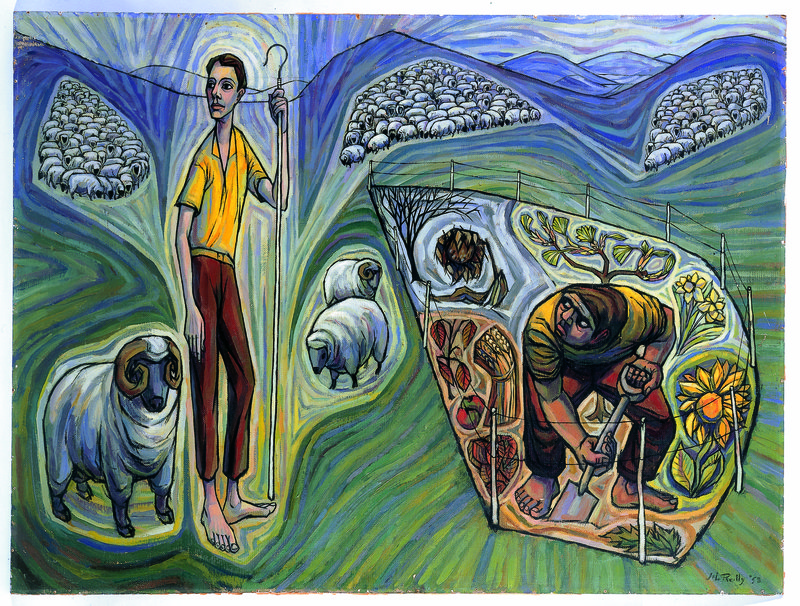
The shocking story of sibling rivalry which ended with Cain’s murder of his brother Abel (Genesis 4:1-12) is clearly illustrated in Reilly’s stylised expressionist style. The artist has selected the moment in the story between the sacrificial gifts to God and the murder. He contrasts the two brothers’ approaches to farming - Cain’s fenced farmland, under intensive cultivation with sunflowers, tomatoes, and daffodils visible, is compared with Abel’s care of his sheep shown in delineated enclosed areas. The acceptance of Abel’s gift of a sacrificial lamb is demarked by a bright and open area in which he and his herds are placed, with a vortex of light representing God’s acceptance of his gift, which descends from heaven and bathes him in its glow. Abel’s figure is long, thin and elegant while Cain, in contrast, is stocky, stooping as he toils to dig his land in a darker area of the canvas, with his rejected sheaf of corn. He directs a murderous look at Abel, his anger and hate conveyed by his demeanour.
This was one of the earliest works to enter the Collection; one of four works by John Reilly which were acquired by Wollen in October 1962. Two others, The Raising of Lazarus and The Feeding of the Five Thousand are on display in Methodist Central Hall, as part of this Art Trail.
The work appealed to some members at Balsall Common because they feel that, even though they live in a commuter village, it still retains agricultural roots, with a farmers’ country market, farm shop and a number of successful farms in the area. The village has also been affected by the construction of the HS2 railway line, so scenes which reflect rural life, such as Cain and Abel with so much detail about farming activity, chime with local communities. Members have reflected on the works together and numerous comments have been fed back including:
“In Reilly’s Cain and Abel the faces are amazing - one content, one angry and questioning, possibly showing hatred. Why has one got life sorted and the other hasn’t?” Joy, Balsall Common Methodist Church
Francis Hoyland Nativity polyptych, oil on canvas, 1961
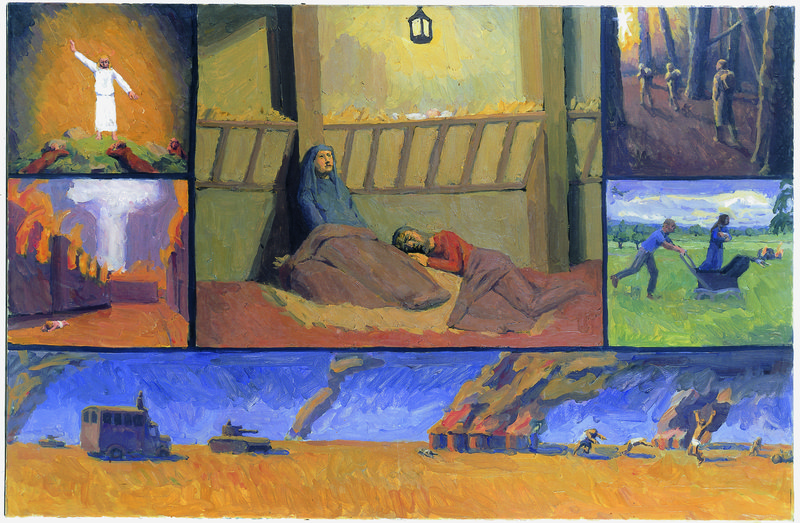
The title references Early Renaissance altarpieces, as Hoyland includes the word ‘polyptych’, which would normally mean an artwork which was made up of more than three panels. In art historical terms paintings of three panels are ‘triptychs’; those with two panels are ‘diptychs’. The panels are usually hinged together and, as a polyptych is made up of a larger central panel, with side panels and a lower panel (called a predella) it often forms a significant altarpiece.
This presentation allows for a narrative approach and Hoyland translates this into a 1960s single canvas with a multiplicity of individual sections laid out in the traditional manner of a ‘polyptych’. Yet the artist tells the story of Christ’s birth in an individual contemporary manner, including references to places he knew well; to major world events and concerns about nuclear warfare.
The traditional Nativity scene is central with Mary and Joseph looking exhausted in the stable and baby Jesus highlighted by a lantern in the manger behind them. (Luke 2:7-11). In the top left panel an angel appears to the shepherds. On the top right three backpackers are shown trekking through Lickey Woods in Hoyland’s native Birmingham, representing the three kings following the star. Below them the Flight into Egypt to escape Herod’s murderous men is given a modern twist with Mary, Joseph and Baby Jesus rushing through Richmond Park with a pram.
The other two ‘panels’ show harrowing scenes as the couple flee and the Massacre of the Innocents (Matthew 2:16), is represented by a nuclear attack, with buildings on fire, a dead baby in the road and the aftermath of a nuclear explosion in the distance. In the lower predella panel the Massacre is shown in terms of the Congolese civil wars, which raged between 1960 and 1965, reflecting wider Cold War alliances with the Soviets and Americans backing different factions.
These interpretations of the well-known biblical texts are intended to make the onlooker pause and consider the relevance of the Christian story in contemporary life, reflecting on the themes of Faith, Hope and Love that are so important at this extraordinary moment in world history.
Hoyland’s religious work was greatly influenced by his Catholic faith and by an early trip to Italy, funded by a scholarship. Of his working process when painting religious works he has written, “as I read the gospels I imagine the people and places they refer to, and, to a certain extent, ‘see’ them. Taking a design through various stages of drawing, etching and painting, gradually clarifies my vision and the understanding of the text. As I attempt to build a credible space the personalities and protagonists become more focused and their relationship to each other more exact. Line is important and colour a joy. The motif for a painting is love.”
This work was acquired, along with a Crucifixion scene by Hoyland, in early 1963. Douglas Wollen was clearly drawn to his penetrating works, having purchased the first one for the Collection in September 1962, the Holy Communion predella. Both of these works are on display at Fillongley as part of this Art Trail. A number of Hoyland’s works are held in public collections such as his large bleak Crucifixion of 1956 in the Arts Council Collection, Requiem in Grundy Art Gallery, Blackpool and his etchings are held by the British Museum and the Ashmolean Museum, Oxford.
Yet Hoyland’s reputation as an artist is no longer held in high regard, even though he had a long and accomplished teaching career, inspiring students at the Royal West of England Art School from 1954-1959. Later, from 1989-2000, he was Fine Art Course Director at Camberwell School of Art, where he himself had studied. He was particularly renowned for his draughtsmanship and printmaking but, in whatever medium he worked, his works are always full of compassion.
Theyre Lee-Elliott Crucified tree form – the Agony, tempera and gouache on paper, 1959
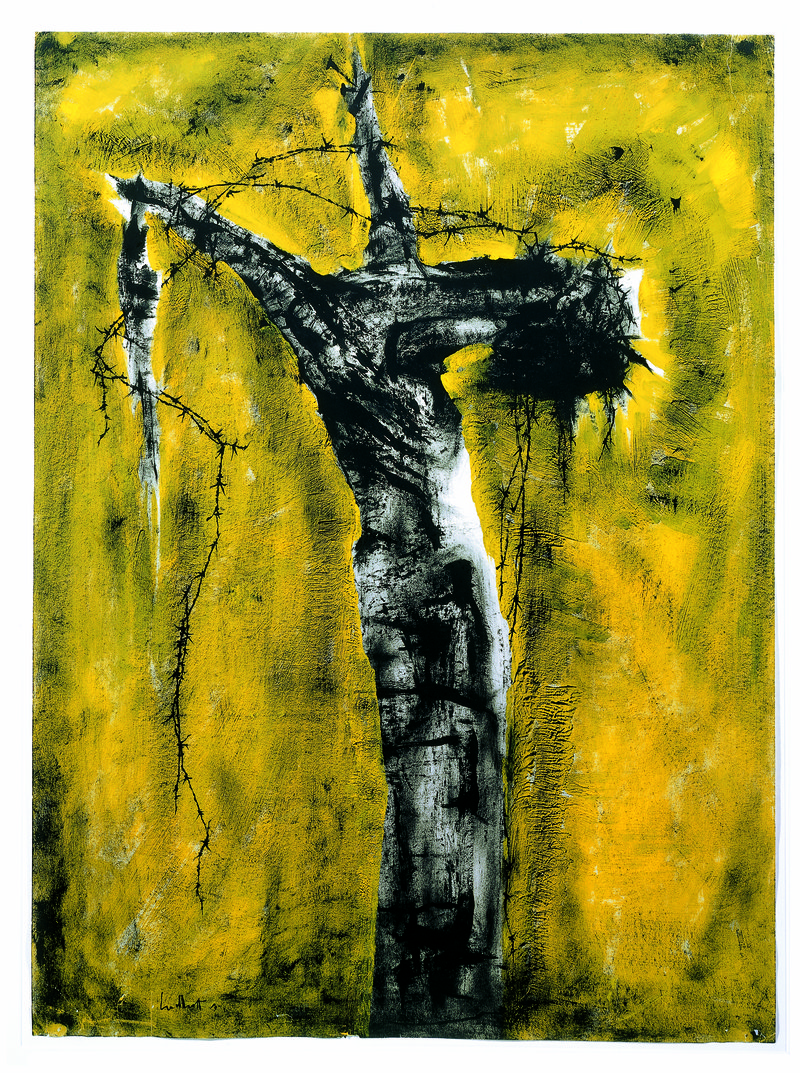
This arresting image with a vivid colour palette in yellow and black draws inspiration from a tradition dating from the 13th century in which the cross on which Jesus is crucified is a living tree. In this painting Christ’s body becomes the tree: his head and shoulders fall forward, and his arms extend like branches, with strands of barbed wire referencing World War 1 trench warfare and dead trees rather than living ones. Although he was a teenager during WW1, Lee-Elliott heard stories of the Western Front from his serving family members.
He is best known as a graphic designer of posters and a painter of ballet scenes. However, in his mid-50s he was gravely ill and afterwards turned for a period to religious art. He produced a series of Crucified tree forms after his recovery, of which this is one of the earliest. These were shown first in Paris and then at the Redfern Gallery in an exhibition entitled The Passion in 1960. It was from the Redfern that Wollen acquired this work in May 1963 for the Methodist Collection. Some of the artist’s powerfully Expressionist religious pictures were selected in 1965 for the British section of the International Exhibition of Religious Art at Musee de’Art Modern in Paris.
Born in Sussex, the son of an Anglican clergyman, the artist regarded himself as agnostic. After studying at Cambridge he moved to London and attended the Central School of Arts and Crafts (1925-1927) before going on to the Slade School of Art. He became renowned as a graphic designer, working for companies such as Imperial Airways, Southern Railways and the General Post Office, famously designing the Speedbird logo in 1932 and the Airmail Wings. In later life he became a recluse, living his last years in Sloane Avenue, Chelsea.
Trees and tree felling has a particular resonance in the Balsall Common area where there has been public anger at the removal of ancient trees and greenery as part of the preparation for the HS2 railway line. Displaying this work here has particular resonance for local people at a time when there is much debate about the Climate Emergency and the role played by trees within the environment. This can be seen in the context of publications such as the Green Bible which have struck a nerve in the religious and environmental community, highlighting verses in the Bible that speak directly to confronting the environmental crisis facing our planet and a deeper understanding of caring for creation. The work spoke to many members in different ways:
“….I felt drawn towards this particular picture and stood looking up at the painting for a while; as I did so, my whole being was affected by what I saw – the true Agony of Jesus Christ as He hung there on the cross. I left with tears in my eyes.” Margaret, Balsall Common Methodist Church
Jacques Iselin The Elements of the Holy Communion, oil on canvas, 1963
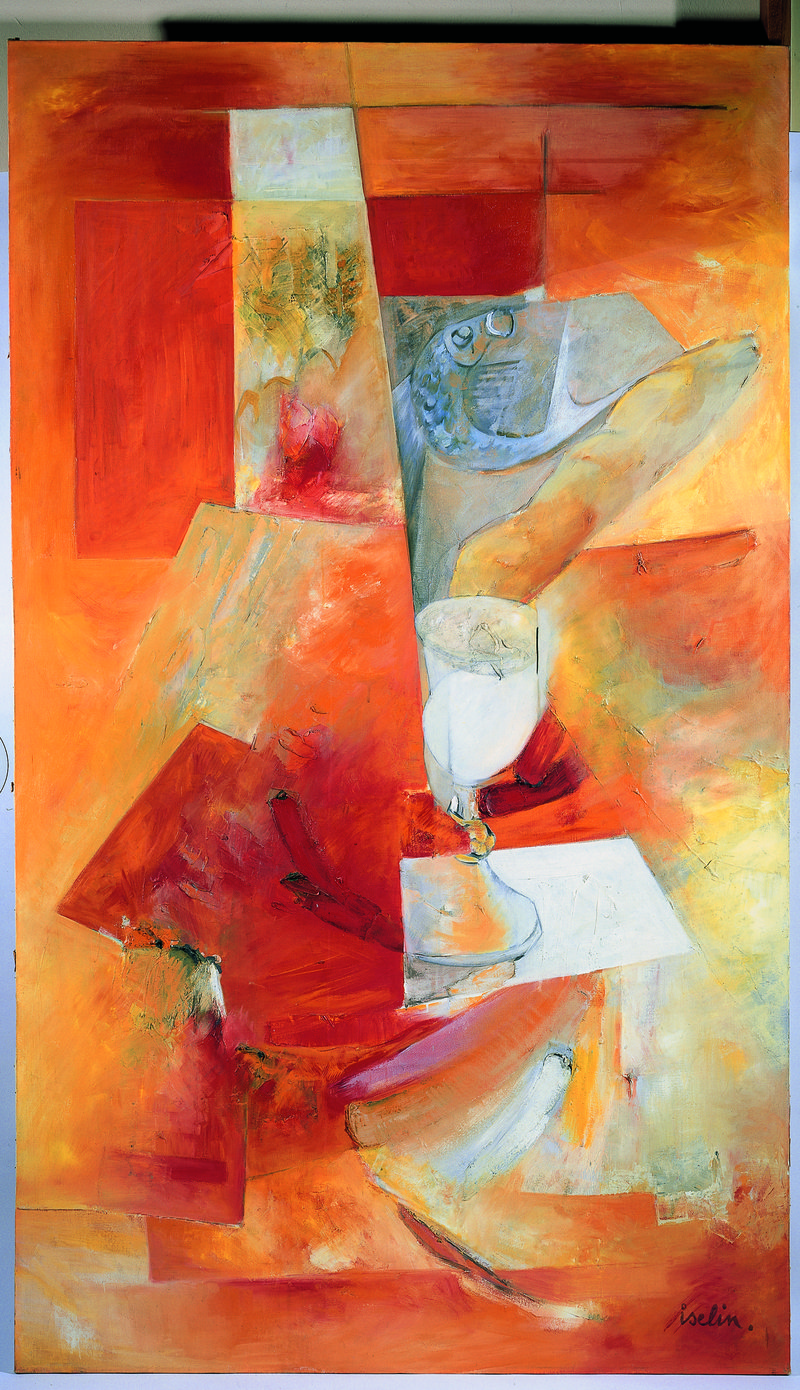
The ‘elements’ of the Holy Communion are the bread and wine (1 Corinthians 11:23-26) which are explored in this work with the depiction of a chalice of wine and the long loaf of bread. Iselin portrays wheat, from which the bread is made, and the Christian symbol of the fish. The Greek word for fish is made up from the initial letters of the Greek words ‘Jesus, Christ, of God, the Son, Saviour’. This combines the literary aspect of the liturgy with the mysterious presence of Christ in the Communion.
The rich warm colours suggest the textiles often used for altar frontals, or the clothing of clergy at Communion services. This is the first work to be commissioned specifically for the Collection by Wollen through the J G Couper Fine Art Gallery in 1963. Iselin drew on studies he had already made for a possible commission for a French Protestant church in Soho Square which did not come to fruition. Many other works have been specifically commissioned for the Collection since the 1990s.
The French artist came to England to teach in London at the Lycee Francais Charles de Gaulle in 1956 and exhibited widely in the early 1960s. Although his artistic reputation has been somewhat lost, this major large work in the Methodist Collection has been a centrepiece for many exhibitions across the country.
David Jones Three Kings, engraved woodblock, 1925
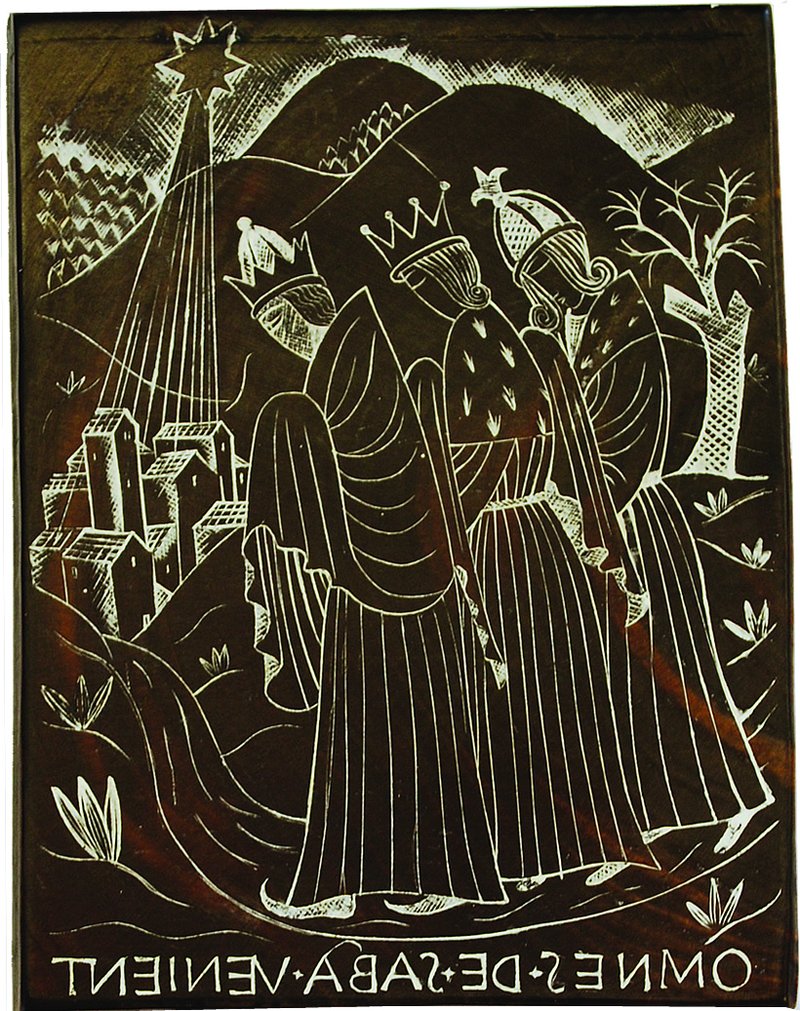
The Three Kings are shown following the star to Bethlehem, as described in Matthew 2:9-10. Below, in reverse, is the inscription ‘Omnes de Saba Venient’ taken from early Epiphany carols and the prophecy of Isaiah 60:6 “All those from Sheba shall come. They shall bring gold and frankincense, and shall proclaim the praise of the LORD.” The text is reversed because it is the original woodblock which would be used to make a print, in this case for a Christmas card in 1925.
Jones was working at the Capel-y-ffin artistic community in the Black Mountains of Wales when he made this. The local hills feature prominently and below them lies Bethlehem (the name of a hamlet in Carmarthenshire) illuminated by the rays of the star. The Three Kings are on foot with their heads slightly bowed, just passing a mutilated tree. It has been suggested that this tree both foreshadows the Crucifixion and reflects Jones’ experience in the battlefields of World War 1.
Jones was half Welsh but was raised in London and trained at Camberwell and Westminster. He is renowned for his Modernist poetry, as well as his printmaking and unique stylised watercolours. He worked closely with Eric Gill and, influenced by him, entered the Catholic Church in 1921. He was engaged to Gill’s daughter Petra at the time he produced this card, but she broke off the engagement in 1927.
Working in Wales stimulated his interest in his Welsh heritage, the culture and landscape. His wood engravings are amongst his greatest works but he moved away from this medium in his later career and began producing original watercolours. In the 1930s he suffered a breakdown and subsequently lived with mental health issues.
The work was not acquired for the Collection until 2009 and complements a number of other works of the 1920s already in the Collection, some of which also reference the impact of WW1 on their artists. The simplicity of this small work attracted many at Balsall Common when they were making their selections:
“The simple use of just white and black makes this a picture to reflect on. The three figures are walking down the path towards their destination… a journey of purpose.” Joy, Balsall Common Methodist Church
Maggi Hambling Good Friday: Walking on Water, 2006, oil on board, 2006
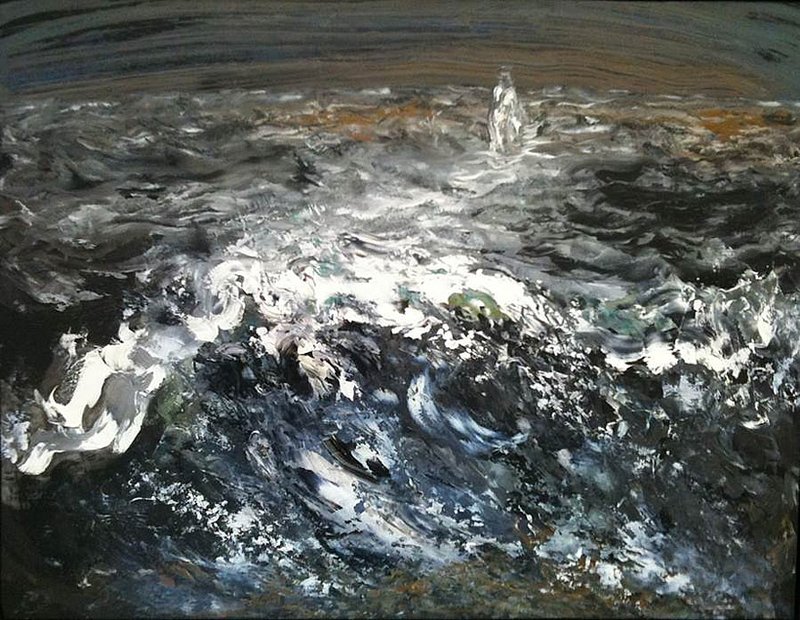
The distant figure of Christ with a shadowy halo is shown walking on stormy waters, rendered in very thick oil paint which reveals the brushstrokes (known as impasto) in virtually monochrome tones, creating a poignant and arresting image (John 6:18-21). Hambling has a strong preoccupation with the sea, and its mysterious power, since witnessing a huge storm on 30 November on the Aldeburgh coast in Suffolk. The link between the sea, chaos and death made in the Christian Old Testament underpins the Gospel account of this moment when Christ walks on the stormy waters of the lake.
The title reflects the fact that each Good Friday Hambling has produced a painting in memory of her late mother, in which she strives to capture the perfect image of life and death at one and the same moment. This painting was her 2006 contribution to the series. Conscious of the myriad biblical references to water, from the first chapter of Genesis onwards, she believes “Each wave can be seen as a self-regenerative force, untameable by man, but speaking of the power of God.”
Hambling is one of the foremost British painters and sculptors of her generation, best known for public art such as The Scallop on the beach at Aldeburgh, a 4-metre high monument, in tribute to the late composer Benjamin Britten, as well as her more controversial recent sculpture commemorating Mary Wollstonecraft in London. She originally came from Suffolk and trained at the Slade and Camberwell School of Art. Hambling celebrated her 75th birthday in October 2020 with an exhibition of self-portraits painted during lockdown as well as others representing endangered animals (Marlborough Gallery, London).
This work was acquired in 2011 and quickly became one of the most popular in the Collection. The community at Balsall Common found it particularly engaging and submitted a number of reflections on the work, including these made during the second lockdown:
“Christ is not seen instantly but He is integral to the stormy waters: in the same way He is present in the troubles of our lives, reaching towards us. We just have to look.” Chris, Balsall Common Methodist Church
“This picture shows me Jesus as the ‘Light of the World’ because His Light is shining across the water. Also the water is rough and I am reminded that although life can be rough at times, Jesus is always with us”. Christine, Balsall Common Methodist Church
Nicholas Mynheer Rest on the Flight to Egypt, oil on canvas 2003

The story of Mary and Joseph fleeing with their baby son is told in Matthew 2:13-15 and has always been popular with artists. Mynheer gives his own interpretation showing the Holy Family taking a moment’s rest in the shade of a tree. With the threat of Herod receding, Mary and Joseph care for their young son.
The artist writes “I remember being told that the Judaean Desert blooms with wild flowers for about two weeks every spring. I had the idea that as the Holy Family travelled across the desert it flowered in response to the presence of The Lord. Even the tree under which they are seen resting has come into fruit; for Nature itself responds to God, praising in its own way. In the words of The Benedicite: ‘O All ye Works of the Lord, bless ye the Lord: praise him, and magnify him forever.’”
Mynheer’s work is largely figurative and is generally inspired by the Bible. This work appealed to members at Balsall Common because of their strong identification with the importance of trees in the area, following the loss of many with the HS2 railway project.
The artist studied Graphic Design at the Hornsey College of Art in London, pursuing a career in advertising before turning to painting full time. He subsequently moved into sculpture and glass design and his stained glass window in Southwell Minster commemorates the sacrifices made by men and women, at the front and at home, during World War 1.
Images above from the Methodist Modern Art Collection © TMCP, used with permission. www.methodist.org.uk/artcollection
The Methodist Church. Registered Charity no. 1132208